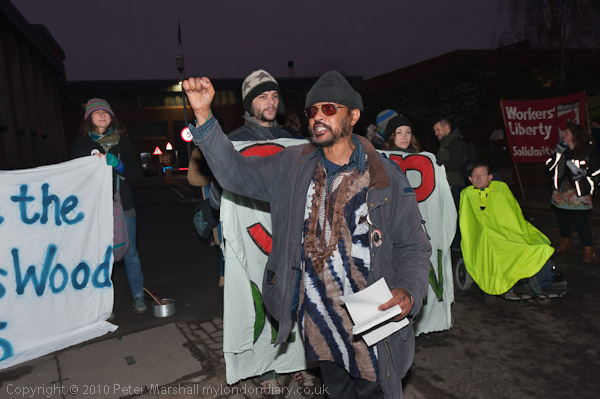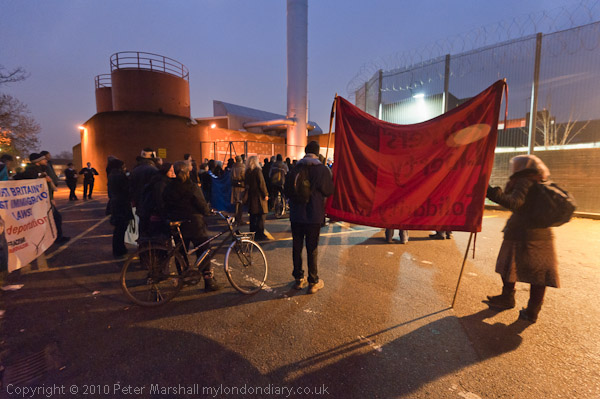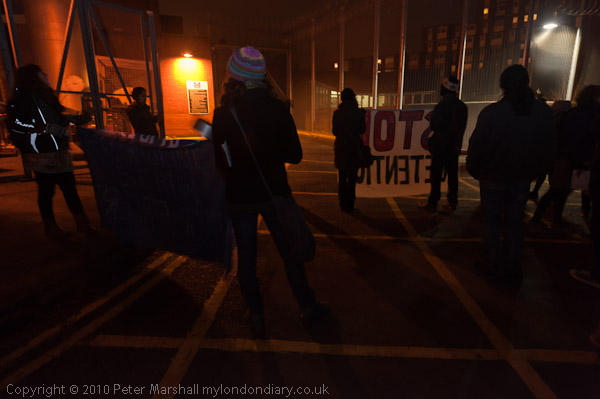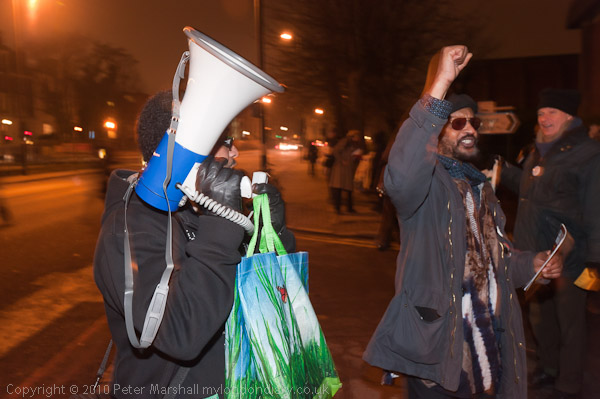On New Year’s Eve I went to photograph a demonstration at Holloway prison (or as it calls itself ‘HMP Holloway‘.) You can read more about the protest calling for the release of the Yarl’s Wood 3 and see the pictures on My London Diary (or Demotix); here I want simply to look at some of the photographic issues. It was an overcast winter’s day, and even in the middle of the day the thick cloud cover had made it seem dark. The protest was starting at 4pm, and I determined to get there early to make the most of the light. I don’t much like having to use flash.
So I arrived at 3.50pm, to find only two people there, though others were beginning to arrive. So I wasn’t able to start taking pictures until a little after 4pm, by which time it was getting to be definitely dark.
While people were standing still, working without flash wasn’t a great problem, using the D700 at ISO 3200 and the 16-35mm wide open at f4 gave shutter speeds around 1/20 second. But once people start getting a little animated, things were rather different, and I had to use flash to get sharp images.
Here’s an example: Two consecutive images as the action was repeated, the first with flash:

1/60 f8, ISO 1250, SB800 flash on camera
the second without:

1/40 f4, ISO 3200. No flash
I made an error in choosing a slower ISO for flash, as it has severely reduced the exposure in the background of the image. I should have kept the ISO at 3200 and also used a wider aperture, perhaps f5.6 which would have put the ambient just around a stop down from the non-flash result.
The closer you get the ambient to the flash exposure, the more the chance of getting a blur combined with the flash on the moving person, often a nice effect, but other times something to be avoided. It might have been better to use a faster shutter speed with the flash, perhaps 1/125, though that would obviously have reduced the ambient fill over the image.
I can’t actually remember what I thought at the time, in fact I think I turned on the flash for the first image and didn’t really have time to think about it. Always easier in hindsight.
Neither image really truly reflects what things looked like. It was darker than the ambient only image suggests (showing detail in the dark skin tones meant I couldn’t afford to cut the exposure) and when using flash there is always the problem of fall-off, which you can fight against a little but not eliminate in outdoor images such as this.
Using flash makes the man in the foreground and his gesture stand out rather better; without flash shows the overall scene better, but he is not quite sharp, possibly both because of the slower shutter speed and less depth of field at the wider aperture.
A further complication in this case was that much of the available light in the foreground area was from sodium street lighting, almost all in the orange-yellow range of the spectrum and quite different from the flash output.
Later, around the back of the prison, some of the most effective pictures Later when it was completely dark and the group was at the back of the prison, there was a different lighting situation, with rather lower light levels and the people much more spread out. Working simply by available light produced some effective near-silhouettes, but when it got really dark some of the better results came from working with a small amount of flash to give a little detail.

16mm, ISO 3200, 1/13 f4 no flash around 30 minutes after “sunset”

An hour later with just a tiny bit of flash fill: 21mm ISO 1250 1/5 f8
For this I was using the ‘slow’ flash setting which allows the use of flash with slow shutter speeds, firing the flash at the start of the exposure (the normal flash setting has a user selected minimum shutter speed in some exposure modes, which I normally have set to 1/60.) I had to make a few experiments to get the flash level low enough to retain the mood of the image.
The Nikon also allows you to set rear shutter curtain flash, when the flash will fire at the end of a long exposure. It’s main use is that it get motion blurs that lead up to the sharp flash image. On this occasion I managed to set it by mistake but took quite a few pictures with it as I found it rather amusing (and there really wasn’t a great deal happening that I hadn’t already photographed.) Using rear curtain flash is, I found rather unpredictable when trying to capture actions, but I rather enjoyed the challenge. It’s rather odd using it, as you get a pre-flash before the exposure and then the working flash at the end of the exposure.

Using slow speed rear curtain flash: 32mm 1/5 f8 ISO1250 Rear flash
More pictures on pictures on My London Diary